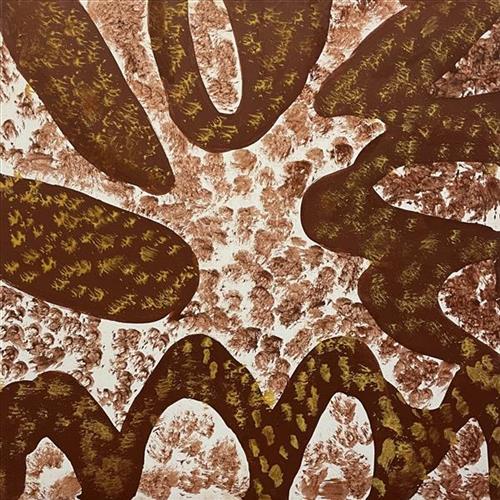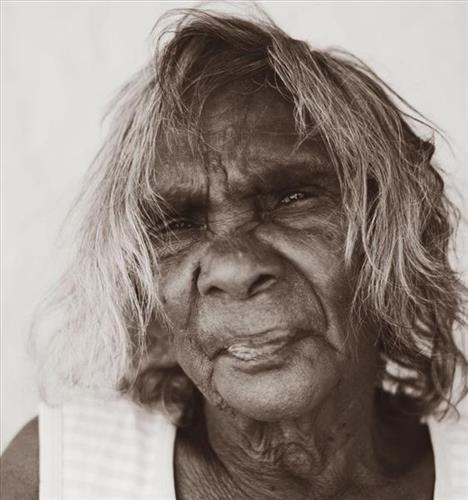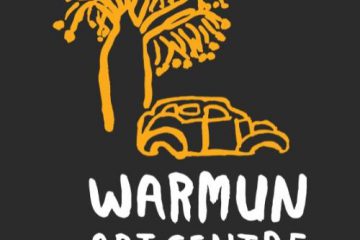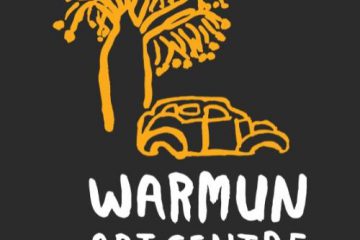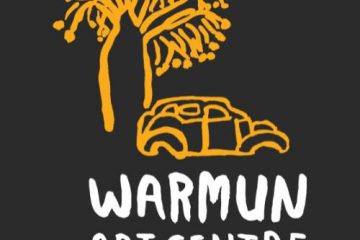Biography:
Peggy Patrick, artist with Jirrrawun Arts and chairperson of the Neminuwarlin Dance Group set up through Jirrawun, has done just about every job that anyone in the Kimberley, man or woman, could have done during the twentieth century apart from helicopter pilot. She has been stockman, drover, station cook, brick maker, windmill mechanic, electrician, barmaid, housekeeper, dressmaker, fencer, nurse, midwife, painter, teacher, singer, dancer, story teller, hunter and keeper of traditional law.
She grew up in the bush learning everything practical, artistic and spiritual connected with traditional life and has the respect of her peers as a law woman. She has been involved in the political and cultural life of the East Kimberley in many ways including time as a member of the Kimberley Land Council (KLC), the Kimberley Aboriginal Law and Culture Centre (KALACC) and the Warmun Executive Committees. She was chairperson of Nine-Mile Community (Gooda-Gooda) at Wyndham for nine years. More recently she was chairperson of Daiwul Gidja Culture Centre working in association with Argyle Diamond Mine to run a successful cross-cultural exchange program.
She has been involved in or touched by all kind of significant historical events. Her family was deeply affected by the tragic events associated with the invasion by Europeans, losing many relations in the Mistake Creek massacre and other relations in the poisoning described in the Joonba first staged at the Telstra Art Award in September 2000. She was a signatory to the first Argyle agreement when the diamond mine started and was deeply involved in the development of the new agreement signed in 2005. She was in Paris dancing Lirrga and the Gurirr-gurirr dreamed by Rover Thomas when Princess Diana died and she met Nelson Mandela in America.
She has wonderful stage presence enabling her to present deeply felt emotion in a public context. In Darwin in September 2000 she spoke moving at the closing ceremony for Rusty Peters and Peter Adsetts "Two Laws, One Big Spirit' show at 24Hour art of the feeling she had for the people who were tragically lost. There was not a dry eye in the gallery.
She led the Neminuwarlin Performance Group in its production of Fire, fire, burning bright at the Perth International Arts Festival and the Melbourne International Festival of the Arts during February and October 2002.
Fire, fire, burning bright was a stage performance telling the story of the Bedford Downs massacre. It incorporated a Joonba, a song and dance cycle, given to a clever man by the spirits of the people who died. The Joonba had been performed in secret by relations in the East Kimberley and never shown to Europeans. Patrick first saw this Joonba when she was a girl of about seven. In 2000 Patrick’s brother the late Timmy Timms and his brother-in-law Paddy Bedford revealed the existence of the Joonba and ‘woke up’ the song rehearsing with Patrick and other relations to stage a performance at the Telstra Art Award in Darwin that year. Plans for the stage performance Fire, fire, burning bright were already under way when Patrick’s brother Timmy Timms died on the last day of 2000. Usually when someone dies, the songs they are deeply associated with are not performed for a number of years after the death. It was a wonderful example of her courage and her deep commitment to maintenance of song and dance and to reconciliation that Patrick was able to keep going as the leader of the performance after losing her brother.
Before Patrick was born her mother had been living at Bedford Downs. Her two older brothers the late Timmy Timms and Freddy Timms’ father were born there. Her father was one of the large group of people arrested and sent to jail after the killing of the bullock that eventually caused the massacre told of in the Joonba. On release from jail the people were given ‘tickets’ and told to return to Bedford Downs. Some threw the tickets away. Those who went back with the tickets were killed. Patrick’s father was one of the people who pulled off the ticket and did not go back to Bedford in Gija country after being in jail.
Patrick's mother was really Miriwoong. After her father was released from jail he picked up her mother and two older brothers and they went to live for a while on Ivanhoe, part of Miriwoong country. Patrick was born near the Ord River during that time, close to the site of present day Kununurra. Her bush name Dirrmingali refers to the brightness of the red rock of Kelly's Knob in the late afternoon. Her other name Barratjil belongs to women of Naangari skin and the eagle dreaming that goes with that skin. It refers to the way the eagle dives to grab his prey with feet outstretched.
When she was a baby her family lived in the bush away from white people for much of the time. They travelled by foot from Ivanhoe back to Doon Doon following the Dunham River, calling at Kingston Rest and eventually going to Theringin, old Greenvale station, now part of Bow River Station. Her parents got work there and stayed. This is where she and her two older brothers grew up and her younger sister and brother were born. When Walter Macale gave up Greenvale, her family went to Turkey Creek for a while.
Then the Lilly's settled at Bow River and Mrs Lilly "saw us young girls going to waste at Turkey Creek with no work." She said "Bring them here and I'll teach them to be kitchen maids, milk nanny-goats, water gardens, iron clothes, clean the house. They can work for me."
Jilba yirrayitjendem wayininka wajbalumga binarriwurrun-yarre."
“We were frightened because we did not know white people."
Well binarriwa yirrayitji-birri wayinigana now. Bow River-yurrung now nawarrarra ngayinany, yirrayin, shift'em yimperrayitbe-yarre Bow River-yurrung now. Warrek yirrani. And danji yirraniyin-ngarri Bow Rivan,
“But we learned to work. We moved to Bow River, we worked there and we stayed there.”
Still gibingarnam mayim jurt yirranyjende yarrewanyga. We never interfere much la wajbalum, nguwangarnan-yarre. Jilba yirrayitjente.
“We still ate mostly bush food. We did not have much to do with the white people. We were still frightened.”
Patrick had eight children. She has lost three of them. She has twenty-eight grand children and thirteen great-grandchildren.
Her first three children, a girl and two boys, were born at Bow River. Her second child, Clancy is the reincarnation of Mamanda, the station worker who was the last person to die as told of in the Joonba. She left Bow River to work for a while with her three children at Moolaboola the then government owned station nearest to Halls Creek. Moolaboola, which had been run as a government camp rather like a concentration camp, was closed when sold to a private owner, Goldman. He loaded everyone onto a truck and took them to Fitzroy Crossing. Peggy and her children were among the people taken.
Patrick was sewing for 'one old missus' at Fitzroy Crossing for a while but was scared that her son Clancy would drown in the river. She then worked for while at Christmas Creek, Derby and Halls Creek before going to work for the Quiltys on Landsdowne.
She worked there for a few years managing a stock camp with her husband John Patrick. She owned her own saddle and did all types of stock work. Her fourth child was born there. She was persuaded to go back to Bow River because her mother needed her there. Her youngest children were born there.
Patrick left Bow River when equal wages were brought in and the managers said "Ah, we can't keep you fellas we can't pay you money." She was still caring for seven children and she went to Wyndham where she started the Guda-Guda community at Nine Mile. She was the chairperson of the village there for nine years and worked at the school and at the hospital. Since then she has lived at Doon Doon, Crocodile Hole, Warmun (Turkey Creek) and Bow River.
From an early age she took an interest in traditional song and dance. She listened to all the songs she heard when she was young and remembers them all.
Junpam tek yirramanjente kirli-kirlirrangem perrayinte-ngarri-yirri,
pinarrik yimperramangpente-yarri. Junpamka interest yirramante-pirri tek yirramanjente, warrk-karri wumperramante, ngalany-ngarri wumperramante, painting-ngarri wumperramante, tek yirramanyjente.
“We used to watch all the different Joonba they brought to our place from the west. They used to teach us to dance, sing, and paint and we watched them.”
Well Growap-karri ngenayin, I bin thinking now ngayi-warriny. Wayinima numpurn-ngerruwa ngayin. Wayinikana Junpam thuwu-thuwum, larrngip perraward-kirri. Ngalanya ngiliyinke now. Warrk kiliyinki, ngalany ngiliyinke, Well wayinikana now ngayina darrngik januwartja-kirri corroboree. Linga-linga ngenard-nguyu junpal now. Any junpa come from nother place, hook'em nyilemenke-pirri straight away.
“When I grew up a bit I thought "I should do that too." Then all the different songs stuck in my head. I sing them now. I dance and I sing. The song is lodged in my brain. Any song that comes from another place I can remember it straight away.”
Peggy has long history of teaching song and dance. She taught thirteen children to dance when she lived at Wyndham and they won a prize with the dance in Darwin. She taught dancing and singing at Doon-Doon school and at the school that used to be at Crocodile Hole.
She has also been in demand as a teacher for adults. The National Aboriginal and Torres Strait Island Dance Theatre invited her to go to Sydney four times with her brother Timmy Timms, sons Clancy and Ray, niece Mona Ramsay and singer, story teller and painter Hector Jandany. They taught traditional song and dance to the city dancers. She worked with choreographer Stephen Page in 1990. On two occasions dancers from the city visited the East Kimberley to show people the dances she taught them.
As well as her long, passionate involvement with the performance arts Patrick was one of the founding members of Jirrawun Arts and has been painting with the company since that time.
© Peggy Patrick, Warmun Art Centre and Frances Kofod
